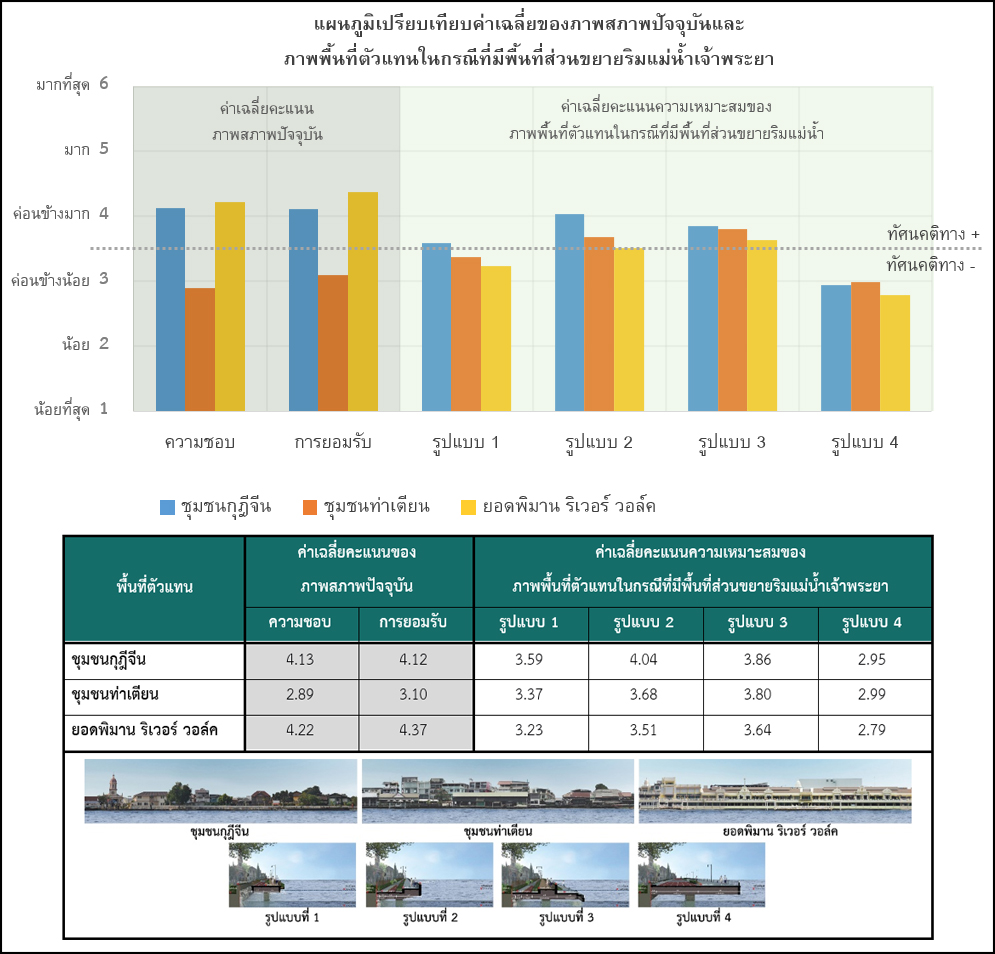Attitudes Towards Changes in Landscape from Chao Phraya Riverfront Extension Project: Community and Commercial Areas
Main Article Content
Abstract
This research studies public attitudes towards changes in the landscape from Chao Phraya riverfront extension project in urban areas, especially in residential communities and commercial areas in order to propose the guidelines for mitigation of the public attitudes in regard to the changes in the landscape along the river. The research framework is applied from the Visual Impact Assessment. The research may be described in six parts. They are: 1) Reviewing and surveying the study areas, selecting representative sites, 2) Define variables of the research, 3) Define population sampling, 4) Designing photo – questionnaires as photomontage technique was applied on selected pictures to depict the appearance of 4 mock-up riverfront extension areas on the front of 3 representative sites and collect data 105 sets, 5) Data analysis using the statistical tools, 6) Summarizing results and formulating guidelines for appropriate developments. The findings indicates that the extension areas along the Chao Phraya River in the residential communities and commercial areas affects public attitudes in different ways. The positive attitudes towards the changes have decreased in the areas where present conditions are already in good condition and look attractive. However, the negative attitudes have decreased in the areas where current conditions are deteriorated. Therefore, the extension areas may not be only the element affecting public attitudes toward changes. The study result reveals that significant elements which affect the attitudes towards changes in negative ways for all the representative sites are the oversized width of the extension areas along the river.
Downloads
Article Details

This work is licensed under a Creative Commons Attribution-NonCommercial-NoDerivatives 4.0 International License.
All material is licensed under the terms of the Creative Commons Attribution 4.0 International (CC-BY-NC-ND 4.0) License, unless otherwise stated. As such, authors are free to share, copy, and redistribute the material in any medium or format. The authors must give appropriate credit, provide a link to the license, and indicate if changes were made. The authors may do so in any reasonable manner, but not in any way that suggests the licensor endorses you or your use. The authors may not use the material for commercial purposes. If the authors remix, transform, or build upon the material, they may not distribute the modified material, unless permission is obtained from JARS. Final, accepted versions of the paper may be posted on third party repositories, provided appropriate acknowledgement to the original source is clearly noted.
References
Anambutr, R., & Suksawang, W. (2013). Visual impact assessment manual. Bangkok: Office of Natural Resources and Environmental Policy and Planning.
Inchan, D. (2014). Tha Tien: Temple, palace, house, retail, market and people. Bangkok: National Discovery Museum Institute.
Marome, W. A. (2016). Enhancing Adaptation to Climate Change by Impact Assessment of the Flood in Bangkok.Journal of Architectural/Planning Research and Studies, 13(2), 33.
Matichon. (2015). Continue “The Chao Phraya riverrfront project” “Prawit Wongsuwan and Anupong Paochinda” enjoin BMA to start constructing the project next year. Prachachat Online. Retrieved February 23, 2016, from http://www.prachachat.net/news_detail.php?newsid=1442390744.
NZ Transport Agency. (2009). Pedestrian planning and design guide. New Zealand: National Office.
Realist Solution. (2016). Various observation of the Chao Phraya Riverfront. Retrieve July 5, 2016 from http://www.realist.co.th.
Rojrudakorn, P. (2013). Streetscape & urbanization in Bangkok. Executive Journal, 32(3), 147.
The Royal Institute. (2012). The royal institute dictionary. Retrieved July 10, 2015, from http://www.royin.go.th/.
Wanlipodom, S. (2015). The Chao Phraya community: Evolution and changing. Retrieved June 21, 2015, from http://lek-prapai.org/home/view.php?id=808.
Yamane, T. (1973). Statistics: An introductory analysis (3rd Ed.). New York: Harper and Row.


